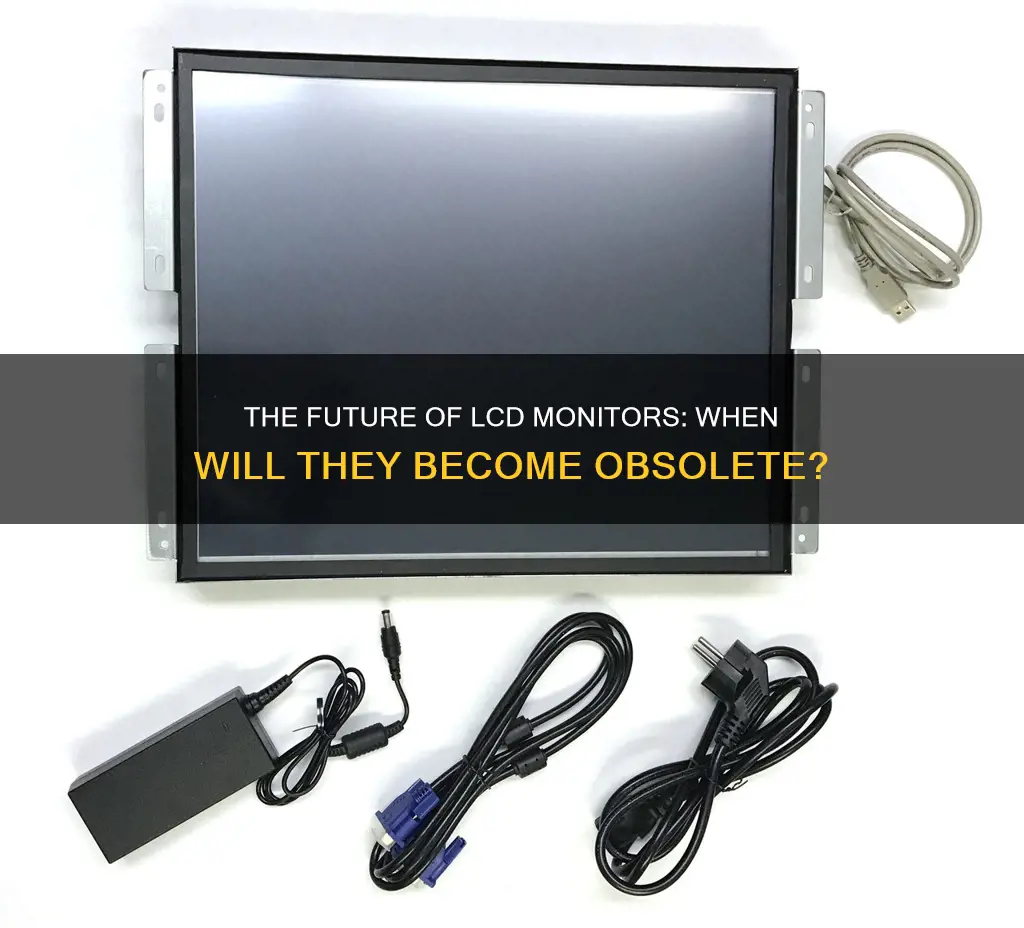
The lifespan of an LCD monitor varies from 30,000 to 60,000 hours, which equates to roughly ten to twenty years of active usage. However, LCD monitors are becoming obsolete due to advancements in technology, such as higher resolutions, faster refresh rates, and better colour accuracy, which might prompt users to upgrade even if their old monitor is still operational. This article will explore the factors that contribute to the obsolescence of LCD monitors and the emergence of newer display technologies.
| Characteristics | Values |
|---|---|
| Average Lifespan | 30,000 to 60,000 hours |
| Average Lifespan in Years | 10 to 20 years |
| Average Lifespan with Low Usage and Proper Care | 40,000 to 65,000 hours |
| Average Lifespan with Ideal Conditions | 30 to 40 years |
| Average Lifespan with Ideal Conditions in Years | Around 35 years |
| Lifespan with High-Quality Electrical Components | More than 50,000 hours |
| Lifespan with Low Brightness | Longer |
| Lifespan with Voltage Stabilizer | Longer |
| Lifespan with Proper Cleaning | Longer |
| Lifespan with Surge Protector | Longer |
| Lifespan with Screen Saver Set to Solid Black | Longer |
What You'll Learn

LCD monitors can last 10-20 years
On average, an LCD monitor can last anywhere from 30,000 to 60,000 hours of use. This equates to roughly 10 to 20 years of active usage, assuming the monitor is used for about 8 hours per day. However, the lifespan of an LCD monitor can be influenced by various factors, and proper care and maintenance can extend its longevity.
The durability of an LCD monitor is influenced by several factors, including the quality of its components, usage patterns, and environmental conditions. High-quality electrical components, advanced technology, and a best-in-class display panel contribute to a longer-lasting monitor. Additionally, the duration of daily usage impacts the lifespan; using the monitor for more than 8 hours per day will likely result in a shortened lifespan, while using it for fewer hours may extend its functional lifetime.
To maximise the lifespan of an LCD monitor, proper care and maintenance are essential. Regular cleaning with a microfiber cloth, avoiding moisture, and keeping the monitor away from smoke and harmful fumes are recommended. It is also crucial to maintain a clean and safe work area, avoiding liquids and ensuring a stable setup. Using a surge protector can help protect the monitor from electrical current fluctuations, and it is important to ensure that air vents are not blocked to prevent overheating.
While LCD monitors can last for an extended period, it is worth noting that technological advancements may render them obsolete before they physically stop working. Higher resolutions, faster refresh rates, and improved colour accuracy may prompt users to upgrade to newer models even if their LCD monitor is still operational.
In summary, with moderate usage and proper care, LCD monitors can be expected to last for a considerable duration of 10 to 20 years. However, factors such as component quality, usage patterns, and maintenance practices will influence the actual lifespan of each individual monitor.
Double Monitor Wallpaper: What Size Do You Need?
You may want to see also

LED monitors are more expensive but longer-lasting
While LED monitors are more expensive than LCD monitors, they are longer-lasting. This is because LED monitors are lit by light-emitting diodes (LEDs), which are very small bulbs that last longer than the cold cathode fluorescent lamps (CCFLs) that lit older LCD monitors. The industry standard for LED lifespan is 100,000 hours, or about 10 years, although this can be affected by factors such as heat, which contributes to diode degradation. LCD monitors, on the other hand, have a lifespan of about 50,000 hours, or 5 years, roughly half that of LED monitors.
In addition to their longer lifespan, LED monitors offer several other advantages over LCD monitors. LED monitors are significantly thinner, lighter, and more energy-efficient than LCD monitors with CCFL backlighting. They also provide more consistent brightness and have a faster response time. The improved energy efficiency and longer lifespan of LED monitors can help offset their higher initial cost.
LED monitors also offer better picture quality than LCD monitors. While there may not be a huge difference in image quality between CCFL-backlit LCDs and LED-backlit LCDs, LEDs light the screen more evenly than CCFLs. This is because CCFLs are larger than LEDs and are placed around the perimeter of the monitor, with light spread using a sheet of plastic. In contrast, LEDs are smaller and can be distributed evenly behind the monitor, providing even lighting across the entire screen.
LED monitors also have advantages when it comes to gaming. A full-array LED LCD monitor with an IPS panel is a good option for most gamers due to its colour accuracy, dimming capability, and ample viewing angles. For hardcore FPS gamers, an LED LCD monitor with a TN panel is ideal because it offers the lowest response times, which can be critical in competitive gaming.
Overall, while LED monitors are more expensive upfront, their longer lifespan, improved performance, and lower maintenance costs make them a more cost-effective option in the long run.
Understanding Monitor Connection Ports and Plug Sizes
You may want to see also

LCD monitors can become obsolete before they stop working
On average, an LCD monitor can last anywhere from 30,000 to 60,000 hours of use, which translates to roughly 10 to 20 years if used for about 8 hours a day. However, LCD monitors can become obsolete before they physically stop working due to advancements in technology. For example, newer technologies may offer higher resolutions, faster refresh rates, and better colour accuracy, prompting users to upgrade even if their LCD monitor is still operational.
LCD monitors are susceptible to becoming obsolete due to factors beyond their physical lifespan. Industry trends and technological shifts can render LCD monitors obsolete as the market demands newer technologies. For instance, the transition from monochrome to colour LCD displays in cellphones during the late 1990s led to the obsolescence of monochrome LCD configurations.
The viability of LCD displays is also influenced by global demand and supply chain dynamics. When demand for specific components decreases, manufacturers may discontinue their production, leading to longer lead times and eventual obsolescence. Additionally, shifts in market needs can cause dramatic changes in global demand for certain technologies, further accelerating the obsolescence of LCD monitors.
It's important to note that while LCD monitors may become obsolete before reaching the end of their physical lifespan, proper care and maintenance can extend their functional lifespan. Factors such as usage duration, voltage fluctuations, dust accumulation, and working conditions can impact the longevity of LCD monitors. Therefore, it is advisable to follow recommended cleaning practices, regulate power fluctuations, and maintain a safe and stable environment for the monitor to prolong its usability.
In summary, while LCD monitors have an average lifespan of 10 to 20 years, they can become obsolete sooner due to technological advancements, industry trends, and market dynamics. Proper maintenance and care can extend their usable lifespan, but staying informed about industry trends and technological shifts is crucial to anticipate and plan for obsolescence.
The Largest Display: Monitor Size Extremes
You may want to see also

Monitor lifespan depends on usage and maintenance
The lifespan of a monitor depends on a variety of factors, including usage patterns, maintenance, and environmental conditions. On average, an LCD monitor can last between 30,000 to 60,000 hours of use, translating to roughly 10 to 20 years when used for about eight hours daily. However, this range can vary significantly depending on how well the monitor is maintained and the specific conditions of its usage.
Usage patterns play a crucial role in determining the lifespan of an LCD monitor. Using the monitor at higher brightness levels can reduce its longevity. Additionally, if the monitor is exposed to extreme temperatures or high humidity levels, its lifespan may be negatively impacted. Therefore, it is essential to ensure that the monitor is used within optimal temperature and humidity ranges as specified by the manufacturer.
Maintenance is another vital factor that influences the lifespan of an LCD monitor. Proper maintenance includes regular cleaning, protecting the screen from physical damage, and ensuring adequate ventilation. When cleaning an LCD screen, it is important to use only soft, lint-free cloths, such as microfiber cloths, to avoid scratching the screen. Distilled water or special screen cleaning solutions are recommended for effective cleaning without causing any damage to the screen. It is also advisable to avoid touching the screen with your fingers, as the natural oils from your skin can be difficult to remove and may build up over time.
In addition to regular cleaning, there are several other measures that can be taken to maintain the monitor and prolong its lifespan. This includes setting the monitor to turn off automatically after a certain period of inactivity, avoiding exposure to direct sunlight, and ensuring that the monitor is not placed too close to magnets or other electronic devices that may interfere with its performance. Additionally, it is important to handle the monitor with care during transportation or when adjusting its position to avoid physical damage.
By following these maintenance tips and ensuring optimal usage conditions, you can significantly extend the lifespan of your LCD monitor. While the average lifespan provides a general guideline, proper care and usage can allow your monitor to exceed expectations and provide many years of reliable service.
Mounting Your ASUS ROG Monitor: A Stand Setup Guide
You may want to see also

LCD monitors are becoming obsolete due to newer flat-panel monitors
LCD monitors are becoming obsolete due to the emergence of newer flat-panel monitors that offer improved features and enhanced performance. Flat-panel displays, also known as thin, lightweight electronic displays, have become the norm for presenting visual content, such as text or images. While LCD monitors are currently the most common type of display, they are facing increasing competition from more advanced technologies.
One of the primary factors contributing to the obsolescence of LCD monitors is the evolution of flat-panel technology. Flat-panel displays now offer higher resolutions, such as 1080p and 4K, surpassing the previous maximum resolution of 1080i for consumer-grade CRT televisions. This shift towards higher resolutions is driving consumers to seek alternatives to LCD monitors, rendering them obsolete over time.
Additionally, flat-panel monitors are increasingly combining touch screen technology, providing users with a more interactive and intuitive experience. Modern smartphone displays, for instance, often utilize OLED panels with capacitive touch screens, showcasing the integration of advanced display and touch capabilities. This integration is another factor contributing to the obsolescence of LCD monitors, which typically lack touch functionality.
Moreover, flat-panel monitors offer improved linearity and thinner profiles compared to their LCD counterparts. Flat-panel displays are usually less than 10 centimetres thick, making them highly sought-after in various applications, including consumer electronics, medical equipment, transportation, and industrial equipment. This versatility and slim form factor further contribute to the obsolescence of bulkier and less versatile LCD monitors.
The obsolescence of LCD monitors is also influenced by advancements in backlighting technology. LED backlighting has become the standard for new displays, offering improved durability and longevity. While LCD screens were initially backlit using CCFL technology, the shift to LED backlighting provides enhanced performance and energy efficiency, making older LCD monitors less desirable.
Lastly, the emergence of alternative display technologies, such as OLED, QLED, and ELD, is accelerating the transition away from LCD monitors. These newer technologies offer unique advantages, such as organic compounds that emit light in response to an electric current (OLED) or quantum dots that create their own light when illuminated by shorter-wavelength light sources (QLED). These innovations provide enhanced colour accuracy, energy efficiency, and display quality, further rendering LCD monitors obsolete.
Stretching Your CS Res ASUS Monitor: Tips and Tricks
You may want to see also
Frequently asked questions
On average, an LCD monitor can last anywhere from 30,000 to 60,000 hours of use, which is roughly 10 to 20 years if used for about 8 hours a day.
Several factors can impact the lifespan of an LCD monitor, such as the brightness level it is typically used at, the surrounding environment, and the quality of its components. Higher brightness settings and extreme temperatures or humidity can reduce the monitor's lifespan. Additionally, while the display may last for many years, other components like capacitors or the backlight may require earlier repair or replacement.
Yes, LCD monitors can become functionally obsolete due to advancements in technology, such as higher resolutions, faster refresh rates, and improved colour accuracy. These advancements may prompt users to upgrade to newer models even if their old LCD monitor still works.
Some warning signs of a malfunctioning LCD monitor include backlight dimming issues, image distortion, flickering, and dead pixels. If basic troubleshooting steps do not resolve these issues, it may be time to consider replacing the monitor.







